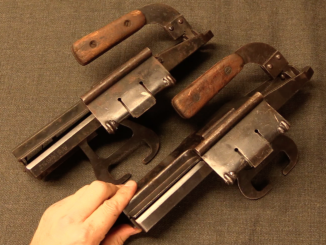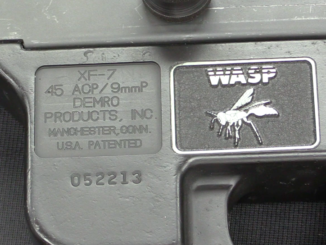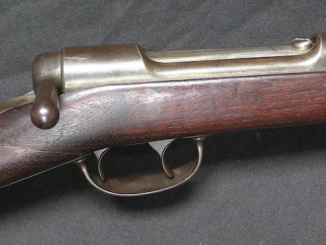When we think of James Paris Lee, we usually think of the British family of Lee-Enfield rifles. However, the US Navy actually adopted an early version of Lee’s action before the British, in 1879. In addition, this rifle was the first use of the detachable box magazine, a patented invention of Lee’s.
Lee initially took his design to the Sharps company, because Remington (where he did have ties form previous firearms endeavors) was trying to push the tube-magazine Remington-Keene rifle into military service. Lee’s design was founded on an attempt to improve upon the tube magazine, and Remington did not want to divide its efforts at that time. The superintendent of the Sharps company at that time was Hugo Borchardt, and he was able to devise an effective way to manufacture Lee’s box magazine. The Navy’s 300 guns were put into production, but Sharp fell into bankruptcy before they were completed.
By this time, the Army had rejected the Remington-Keene, and Lee was able to interest the company in his rifle. He took the partial receivers from Sharps over to Remington, where the rifle order was completed and delivered. Remington would call it the Remington Magazine Rifle, but collections today know it as the Remington-Lee model 1879. More sales would follow, and Remington would slowly improve the rifle bit by bit. Tomorrow, we will take a look at the 1885 model…




Thanks Ian. Good presentation.
I noticed the 45/70 Springfield trapdoor sight and clean rod on this gun.
What is the caliber of the Remington-Lee model 1879, still 45/70?
Did they ever see any action and when did the military (Navy) declare them surplus and got ride of them?
Regards
Pat
The 1879 and 1885 were both .45-70. One way the Navy got money out of the penny-pinching Congress for them was to point out that by going to a rifle using the “new” standard .45-70 round, they could get rid of the hodgepodge of odd-caliber Civil War leftovers that the fleet and the Marines were using up to that time.
These included Sharps & Hankins .52 Spencer-caliber carbines, Gallaghers and Starrs converted to .52 Spencer, some Maynards still using the separate-primed .50 round, and even some .50 Ball repeaters (GOK where those came from).
The Marines technically had a standard rifle, but what that meant was that they had a bunch of Springfield 1863 Allin conversions in .50-70 inherited from the Army.
Pity the poor naval stores and armory officers. Their lot hadn’t improved since Appomattox.
As to why the Navy and Marines didn’t have .45-70 “Trapdoors”, keep in mid that the first full issue of them to Army units in the West (who had first call on new equipment for obvious reasons) had only occurred in the fall and winter of 1875-76. (Custer’s 7th only got theirs a few weeks before Little Big Horn; some of Reno’s section still had .50-70s in the battle.) And of course it’s practically a USMC tradition to be “sucking hind t*t” where hardware is concerned.
The upshot was that in 1878, Congress gave the War Department a line-item in their budget for replacement of Navy and Marine rifles with .45-70s. On a one-for-one basis.
This is the reason the first buy was only 300. They also had to “accept” Springfield-made M1874 “Trapdoors” in .45-70 which were “excess to Army requirements”- a polite term for ones that had failed to qualify for acceptance stamps but were still considered “serviceable”. (By who was never made entirely clear.)
As to seeing combat service, reports vary. Marines definitely saw action in various “colonial” fraci around that time, notably in the “Sandwich Islands” (aka Hawaii). Any such action from about 1880 on could have involved Remington-Lee repeaters.
Also, some sources state that during the 1900 Boxer Rebellion in China, while the Marines who were part of the relief column had the 6mm Winchester-Lee “Navy” straight-pull bolt-action, the actual Embassy Marine detail still had Remington-Lee .45-70s, because their only support weapons, a pair of M1883 “camel” Gatling guns, were also .45-70s.
You see, nobody was expecting trouble, least of all the diplomats. As H. Beam Piper once said, “The unrealistic beliefs of diplomats and statesmen are what soldiers die of”. (“He Walked Around The Horses”, online at Project Gutenberg;
http://www.gutenberg.org/files/18807/18807-h/18807-h.htm
)
cheers
eon
Galt, Ontario has a memorial with a bronze plaque dedicated to Lee, somewhere in a public park near the local river if I recall correctly. I was pleased to happen upon it, and was only a little amused to see that Galt claims him as their own, even though he was born in Hawick, Scotland.
The Presbyterian minister in Hawick was upset at the idea of a plaque commemorating a gun designer being placed on his kirk…
Great video! This is a really interesting weapon. Really enjoy learning about these old models. Thanks for sharing!
Alas, poor Lee’s innovation got rejected because most of the top brass believed that detachable magazines were a waste of perfectly good steel and time.
“Does anybody in this room apart from the inventor know how to load and shoot this pampered-poodle piece of junk?” the Ordinance Board would ask.
“No, sir.”
The first issue version of the British Lee, the Lee-Speed with a six-shot detachable box, had the box chained to the rifle to prevent it “being lost”. Exactly what good that did in a hot fight with the locals in Bechuanaland or wherever was never made entirely clear.
One big selling point of the otherwise undistinguished M1892 Krag-Jorgenson was that its side-loading box was a permanent installation and thus couldn’t be “misplaced”. Another was that since it did load from the side, a live round could be kept in the chamber while loading in case an obstreperous Apache came running up on you while you were topping off the magazine. (An attribute shared with most of the tube-magazine lever-actions of the day, and one which would appeal to an Ordnance Board composed largely of men whose combat experience was mainly vs. said Native American nations.)
It still showed up rather poorly vs. the Spanish Mauser in 7 x 57 a few years later. Which was how we ended up with the Springfield in .30-03, followed by the perfected .30-06 version.
All’s well that ends, I guess.
cheers
eon
Yes, countering melee ambushes would be a plus for the Krag-Jorgensen. It was also a thing for the Johnson rifle and the Johnson Light Machine Gun. Topping off the mag without being vulnerable to sudden knife attacks is something I’d like to have in an urban fight too… Or am I wrong?
Lee-Metford Mk.1 (not “Lee-Speed”, which were commercial models), and it was 8 rounds in a single-stack.
True on both, but the first issued version was a carbine for the cavalry, also called the “Lee-Speed” and with only a six-shot magazine. Basically the sporter magazine and action with a more “military” stock. Like the No. 5 “Jungle Carbine” of 1945-47, it was noted for a wandering zero and a mule-like kick. 😉
cheers
eon
Erm, MLM Mk.I long rifle approved 1889 (LoC para 5877), the first carbine wasn’t even trialled until 1892, and was approved on Sept 29 1894 (LoC para 7751). The magazine is double-stack (like the MLM Mk.II but shorter), and interestingly, the rearsight of the carbine is graduated for cordite and not BP.
Some “Volunteer” patterns were marked “Lee-Speed Patents”, but the first version issued was very definitely the MLM Mk.1 rifle and not the carbine. No official designations of “Lee-Speed” exist.
I suggest you get a copy of Skennerton, “The Lee-Enfield Story”.
The Remington-Lee is a direct ancestor of the Lee-Enfield, and the Model 1879 .45-70 magazine will still enter and properly latch into the No.4 Enfield magwell with the cartridge presented correctly for the bolt to catch the rim and feed it into the chamber.
Unlike the Gibbs .45-70 conversions with their proprietary 3-round magazines, I can just flick the bolt forward with my No.4 and it’ll slide a big fat .45-70-500 into the chamber.
The extraction cam on the front of the ejection port / back of the receiver ring, seems to have been standard practice for the times. The early Mausers show the same feature, as do all models of Mosin Nagant.
Great informative video, Ian. My father recently gave me a few firearms which included a Lee 1879. Serial #599. Only the Lee Arms stamp is on the receiver so would this early of serial number still be part of the original Sharps manufacturing? Not sure where Dad aquired it other than at an estate sale here in Michigan many years ago.
I was curious as to the purpose of the slide button on the magazine so thanks for including in your presentation. That and the method used to remove the bolt. I too will pass on prying with screwdriver!
Thanks again!
Yes, that should be a Sharps receiver. Congrats on having a cool rifle!
I have acquired a version of the M1879 (I think). The wooden front stock in not as long as the one in the video and there is no rod. It is stamped with “The Lee Arms Co. Bridgeport, Conn. USA Patented Nov 4th 1879” and then 525. Would I be correct in assuming that it is just a slightly different version of the M1879?
i have a Remington-Lee 1885 Rifle i’ve had for many years like 45 to be exact in excellent condition i shoot it on special occasions like the Vietnam Birthday,Marine Corps Birthday veterans day 4th of July and Dec.7th i also have the cartridge belt along with the baynet,scabbert and frog ,it seen service on the uss philadelpia and the uss monterey ,i have yet to see who this rifle was issued to its after many years ive had no progress ,well at least i have a magnificent rifle and a piece of history and it being the first of its kind being a magazine fed weapon Rick H. USMC Vietnam Vet